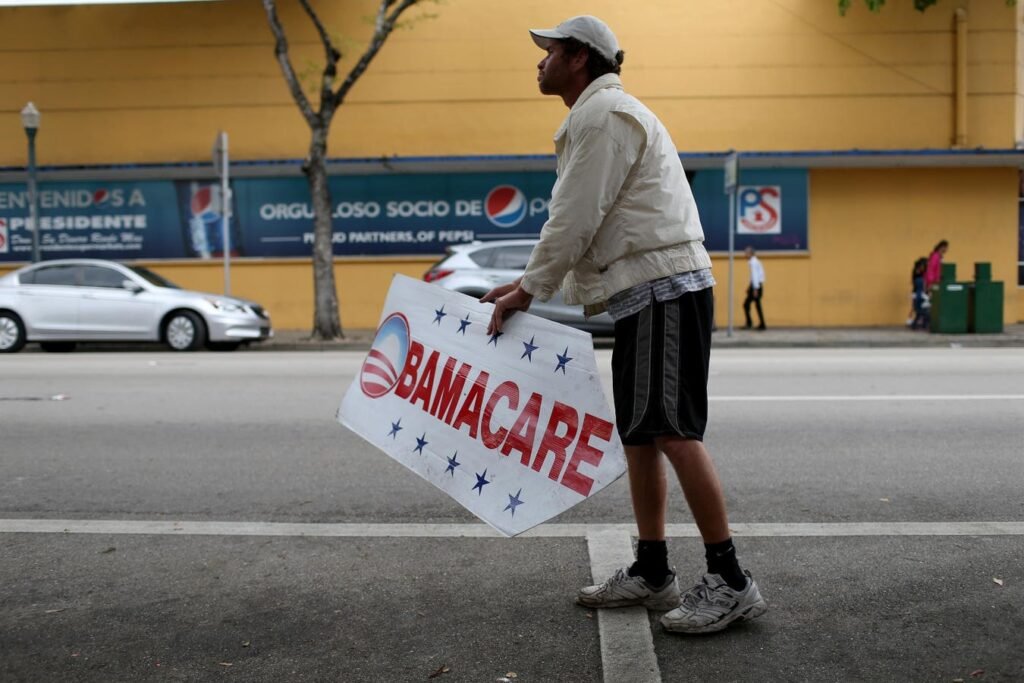MIAMI, FL – FEBRUARY 05: Pedro Rojas holds a sign directing people to an insurance company where they can sign up for the Affordable Care Act, also known as Obamacare, before the February 15th deadline on February 5, 2015 in Miami, Florida. Numbers released by the government show that the Miami-Fort Lauderdale-West Palm Beach metropolitan area has signed up 637,514 consumers so far since open enrollment began on Nov. 15, which is more than twice as many as the next large metropolitan area, Atlanta, Georgia. (Photo by Joe Raedle/Getty Images)
Getty Images
According to an analysis by KFF, major changes to different parts of ACA premiums are likely to send insurance costs for Americans under the scheme soaring next year. The Affordable Care Act established in 2010 under President Barack Obama offers health insurance at competitive and standardized rates to Americans who are neither covered under low-income programs like Medicaid or Medicare nor through their employers.
The published data shows that especially Americans with medium-sized incomes would see the cost of health insurance skyrocket. This is due insurers upping premiums in 2026 but also enhanced premium tax credits expected to expire under the current administration of President Donald Trump, leaving those with incomes of more than 400% of the federal poverty level without a price cap for their coverage.
This chart shows the expected increase of Affordable Care Act insurance premiums in 2026, by income and age.
Statista
Americans with lower incomes would still be able to benefit from income-percentage price caps, even if they are a little higher under the new tax rules in lieu of enhanced credit. Those with much higher incomes had not been hitting their caps previously, had therefore been paying market rates anyways and are not affected by cap changes. This leaves especially those with medium incomes in the rain, as they are shouldering both price increases by insurers as well as cap eliminations (while a someone with a much higher income would only pay the price increases from insurers).
For example, a 45-year-old individual covered under a benchmark silver plan earning $65,000 a year (415% of federal poverty line) would see a cost increase of almost $2,500 annually. Cap changes and insurers’ price increases would each up insurance cost by more than $1,200 for a person with the above characteristics. A 45-year-old earning $90,000 (575% of FPL) would see an increase of around $1,200 in insurers’ cost only. The calculation changes a bit in the case of a 60-year-old couple due to the cost of coverage being higher for older people. At an annual income of $85,000 (402% of FPL), combined cap and insurance cost increases would see premiums soar by an astonishing $22,000 per year. At a $125,000 income (591% of FPL), the couple would still have hit its cap previously and would pay an additional $19,000 in combined cap elimination and insurers’ premium increases.
Insurers To Raise Prices Even More
The KFF calculation from the end of September is based on insurers’ premiums rising by 18% on average. At the end of October, KFF said that they now expect those premiums to rise by 26%. The price of insurance itself is increasing to due strong inflation concerning the cost of care, but higher premiums—made even worse by the expected end of enhanced premium tax credits—are also causing a perceived downwards spiral for insurers. As ACA coverage is voluntary, they expect especially healthier people to drop it over price increases, leaving insurers to expect a sicker insured population costing them more. In September, insurers said that 14% of increases were due to cost inflation and 4% due to changes in the insured population.
All in all, KFF expects the ACA-insured to pay 26% more on average in gross terms due to insurance cost increases, but 118% more in net terms due to the possible elimination of enhanced premium tax credits. Previously, enrollees from households making $22,000 a year (141% of FPL) had not paid any premiums due to tax credits. In 2026, they could be paying a cap of 3.6% of income, in this case around $800. At a household income of $55,000 (351% of FPL), the previous cap stood at 7.3%, which could now rise to 10%—the difference between paying $4,000 and $5,500 for annual coverage. At an annual income of $65,000 (415% of FPL), the previous cap of 8.5% would have kept premiums as low as $5,500 a year. Without a cap, this could now rise by thousands or ten-thousands depending on age, location and insurance plan. Those with incomes close to or somehwhat above the dreaded, so-called subsidy cliff at 400% of the federal poverty level are bound to see the most hair-raising increases.
Charted by Statista


